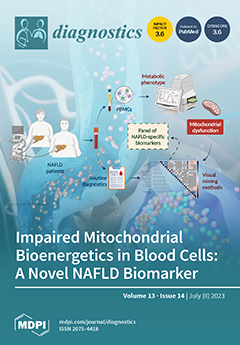We investigated the role of Coefficient of Variation (CoV), a first-order texture parameter derived from
18F-FDG PET/CT, in the prognosis of Non-Small Cell Lung Cancer (NSCLC) patients. Eighty-four patients with advanced NSCLC who underwent
18F-FDG PET/CT before therapy were retrospectively studied.
[...] Read more.
We investigated the role of Coefficient of Variation (CoV), a first-order texture parameter derived from
18F-FDG PET/CT, in the prognosis of Non-Small Cell Lung Cancer (NSCLC) patients. Eighty-four patients with advanced NSCLC who underwent
18F-FDG PET/CT before therapy were retrospectively studied. SUVmax, SUVmean, CoV, total Metabolic Tumor Volume (MTV
TOT) and whole-body Total Lesion Glycolysis (TLG
WB) were determined by an automated contouring program (SUV threshold at 2.5). We analyzed 194 lesions: primary tumors (
n = 84), regional (
n = 48) and non-regional (
n = 17) lymph nodes and metastases in liver (
n = 9), bone (
n = 23) and other sites (
n = 13); average CoVs were 0.36 ± 0.13, 0.36 ± 0.14, 0.42 ± 0.18, 0.30 ± 0.14, 0.37 ± 0.17, 0.34 ± 0.13, respectively. No significant differences were found between the CoV values among the different lesion categories. Survival analysis included age, gender, histology, stage, MTV
TOT, TLG
WB and imaging parameters derived from primary tumors. At univariate analysis, CoV (
p = 0.0184), MTV
TOT (
p = 0.0050), TLG
WB (
p = 0.0108) and stage (
p = 0.0041) predicted Overall Survival (OS). At multivariate analysis, age, CoV, MTV
TOT and stage were retained in the model (
p = 0.0001). Patients with CoV > 0.38 had significantly better OS than those with CoV ≤ 0.38 (
p = 0.0143). Patients with MTV
TOT ≤ 89.5 mL had higher OS than those with MTV
TOT > 89.5 mL (
p = 0.0063). Combining CoV and MTV
TOT, patients with CoV ≤ 0.38 and MTV
TOT > 89.5 mL had the worst prognosis. CoV, by reflecting the heterogeneity of glycolytic phenotype, can predict clinical outcomes in NSCLC patients.
Full article






